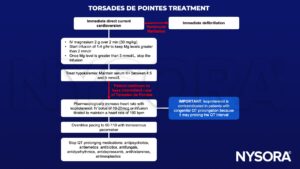Learning objectives
- Describe the underlying mechanisms of QT prolongation
- Manage patients with QT prolongation in the perioperative period
- Treat Torsade de Pointes
Definition & mechanisms
- The QT interval is a measure of the time between the start of the Q wave and the end of the T wave and represents the time taken for ventricular depolarization and repolarization
- QT prolongation is caused by malfunction of cardiac ion channels impairing ventricular repolarization
- This predisposes to the development of the polymorphic ventricular tachycardia torsade de pointes
- May revert spontaneously back to sinus rhythm causing syncope or degenerate to ventricular fibrillation causing sudden death
- Can be congenital (mutations in ion channel genes) or acquired (caused by drugs, neurological injury, or metabolic abnormalities)
- The increase in sympathetic tone associated with the stress of anesthesia and surgery can provoke Torsade de Pointes in patients with QT prolongation, and some medications used during anesthesia can prolong the QT interval
Management

Torsade de Pointes treatment

Suggested reading
- Cohagan B, Brandis D. Torsade de Pointes. [Updated 2022 Aug 8]. In: StatPearls [Internet]. Treasure Island (FL): StatPearls Publishing; 2022 Jan-. Available from: https://www.ncbi.nlm.nih.gov/books/NBK459388/
- O’Hare M, Maldonado Y, Munro J, Ackerman MJ, Ramakrishna H, Sorajja D. Perioperative management of patients with congenital or acquired disorders of the QT interval. Br J Anaesth. 2018;120(4):629-644.
- Hunter JD, Sharma P, Rathi S. Long QT syndrome. Continuing Education in Anaesthesia Critical Care & Pain. 2008;8(2):67-70.
- Kies SJ, Pabelick CM, Hurley HA, White RD, Ackerman MJ. Anesthesia for patients with congenital long QT syndrome. Anesthesiology. 2005;102(1):204-210.
We would love to hear from you. If you should detect any errors, email us customerservice@nysora.com


